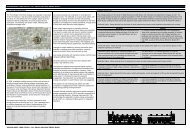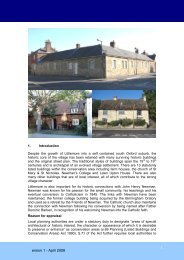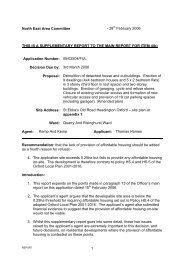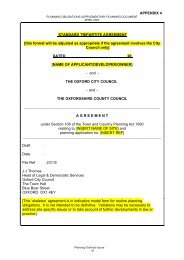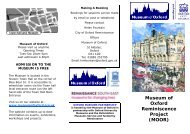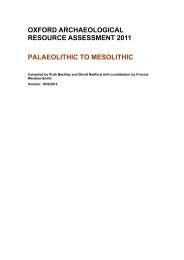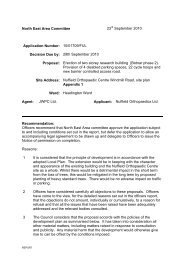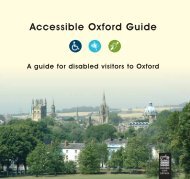Post-medieval Oxford - Oxford City Council
Post-medieval Oxford - Oxford City Council
Post-medieval Oxford - Oxford City Council
You also want an ePaper? Increase the reach of your titles
YUMPU automatically turns print PDFs into web optimized ePapers that Google loves.
the Dutch style (as shown on Williams remarkable view of 1732) and finally<br />
landscaped in the early 19th century in the informal style.<br />
Wadham College (RPG 2317)<br />
Wadham College gardens date primarily to the 18th century when the formal garden<br />
designs (shown on Loggan’s view) were replaced with the informal style. The Grade<br />
II (RPG) gardens were more recently re-designed after World War II and include<br />
lawns, mixed borders and mixed specimen trees. The garden is bounded by a Grade<br />
II 16th century stone wall to the west (LB Ref 5/187H) and a 17th century Grade II<br />
stone wall to the east (LB Ref 6/187D).<br />
Worcester College (RPG 1434)<br />
The gardens of Worcester College cover approximately ten hectares and include<br />
gardens, playing fields and ponds; they are Grade II* (RPG). The college was<br />
founded in the 13th century as a monastic college. It was dissolved in 1541 and its<br />
buildings were taken over by Gloucester Hall. The college was re-founded in 1714 as<br />
Worcester College. The garden probably dates largely to the early 19th century when<br />
the crescent shaped lake was added following the creation of the canal in 1788. A<br />
16th century Grade II gatehouse is located to the south of the lake.<br />
Ceremony and religion<br />
The Church of England did not undertake significant church building in the 16th to<br />
18th centuries, however, rebuilding programmes did have an impact in the 18th<br />
century. For example, St Peter le Bailey, <strong>Oxford</strong> was rebuilt in 1726 and All Saints in<br />
1706-8. For details of post-<strong>medieval</strong> architecture, see RCHM (1939) and Sherwood<br />
and Pevsner (1974).<br />
Churches – archaeological investigations<br />
All Saints Church<br />
The Late Saxon and <strong>medieval</strong> church was demolished and rebuilt in a 1706-8 design.<br />
Excavations for the basemented college library with All Saints Church investigated<br />
beneath the standing 18th century structure. <strong>Post</strong>-1700 features consisted of brick<br />
burial vaults and inhumations set within the rubble demolition of the <strong>medieval</strong> church<br />
(Dodd ed. 2003: 232).<br />
St Ebbe’s<br />
Archaeological investigations at St Ebbe’s Church in 2004 (UAD 1634) recorded<br />
evidence of inhumations within the former churchyard comprising eleven burials from<br />
between the 17th - 19th centuries (Parsons 2004: 10).<br />
St Peter-le-Bailey<br />
Excavation on the site of the churchyard of St Peter le Bailey at Bonn Square in 2008<br />
for lamp posts, revealed a total of 296 burials of <strong>medieval</strong>-19th century date. The<br />
analysis of the skeletons provided a rare opportunity to study the health and disease<br />
of the population of one of the poorest parishes in <strong>Oxford</strong> during the <strong>medieval</strong> and<br />
post-<strong>medieval</strong> periods. The results demonstrated that the later population suffered<br />
from the effects of hard labour, crowded living conditions, pollution and poor hygiene<br />
(Webb and Norton 2009).<br />
St Peter in the East<br />
A rare example of a wooden font was recorded at Parham House in Sussex in the<br />
late 19th century and was said to belong to St Peter’s of <strong>Oxford</strong> (Swann 1897: 65).<br />
OXFORD ARCHAEOLOGICAL RESOURCE ASSESSMENT- POST MEDIEVAL<br />
40



